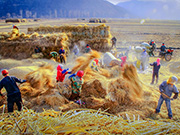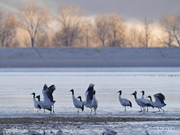

Infrared cameras have captured photos and videos of rare animals in a natural reserve in central China’s Hunan province, according to the reserve’s management bureau.
The rare animals were found in the Jiuyi Mountain National Nature Reserve in Ningyuan County after the reserve sorted out 72,137 pictures and video clips shot on 60 infrared cameras set up this year.
Yellow-bellied Tragopans and Elliot’s Pheasants, species under first-class national protection in China, were spotted for the first time in the reserve.
Xiao Youtie, an engineer with the reserve’s management bureau, said they also found seven species under the country’s second-class national protection, including silver pheasants, golden pheasants, and Tibetan macaques, as well as land wildlife with important ecological, scientific and social value, such as the Chinese muntjac.
Covering an area of more than 600 hectares, the reserve houses 3,445 biological species, with Chinese researchers discovering new endangered plant species in the area.
The reserve has conducted a wildlife survey since 2019, said Zhao Limin, chief of the reserve, adding that it has worked with research institutions such as the Central South University of Forestry and Technology and set up 60 infrared cameras this year to protect biodiversity.
Ningyuan County has embraced green development in recent years. With its forest coverage standing at 69 percent, this year the county was added to the China Biosphere Reserve Network.
 |

 Award-winning photos show poverty reduction achievements in NE China's Jilin province
Award-winning photos show poverty reduction achievements in NE China's Jilin province People dance to greet advent of New Year in Ameiqituo Town, Guizhou
People dance to greet advent of New Year in Ameiqituo Town, Guizhou Fire brigade in Shanghai holds group wedding
Fire brigade in Shanghai holds group wedding Tourists enjoy ice sculptures in Datan Town, north China
Tourists enjoy ice sculptures in Datan Town, north China Sunset scenery of Dayan Pagoda in Xi'an
Sunset scenery of Dayan Pagoda in Xi'an Tourists have fun at scenic spot in Nanlong Town, NW China
Tourists have fun at scenic spot in Nanlong Town, NW China Harbin attracts tourists by making best use of ice in winter
Harbin attracts tourists by making best use of ice in winter In pics: FIS Alpine Ski Women's World Cup Slalom
In pics: FIS Alpine Ski Women's World Cup Slalom Black-necked cranes rest at reservoir in Lhunzhub County, Lhasa
Black-necked cranes rest at reservoir in Lhunzhub County, Lhasa China's FAST telescope will be available to foreign scientists in April
China's FAST telescope will be available to foreign scientists in April